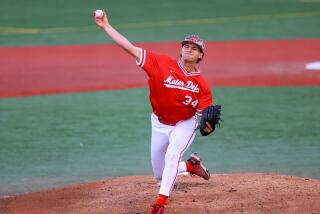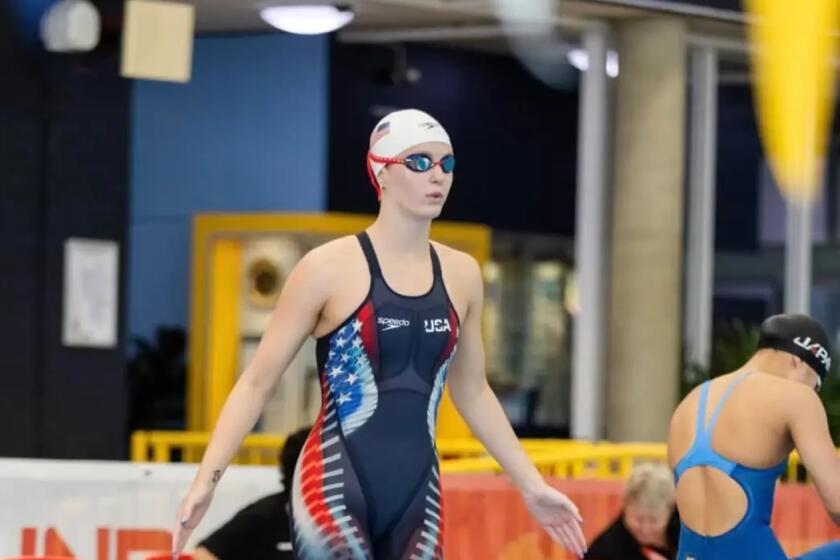THE HITTERS : San Clemente’s Shean Is a Rarity on the Softball Diamond--a Batter With Power
- Share via
Michelle Shean of San Clemente High School’s softball team has a .388 batting average. In 15 games, she has 19 hits, including 5 home runs, 4 doubles and 3 triples. She has knocked in 20 runs.
All of which makes Shean a rarity, a power hitter in a sport dominated by pitchers.
There is an unusually bountiful crop of talented Orange County pitchers this season. Michele Granger of Valencia, Tiffany Boyd of Woodbridge, Ruby Flores of Sunny Hills, Terry Carpenter of Edison, Rae Rice of Fountain Valley and Cheryl Longeway of Kennedy are among the pitchers with reputations for wicked fastballs and riseballs that serve to keep hitters, even good ones such as Shean, off base.
So hitters try to counter with their own tricks of the trade.
Practice, patience, experience, good technique and confidence are among the ways batters can strike back.
Shean stays after practice to take extra batting practice with Mike Conlon, the Tritons’ coach.
“A lot of hitting is practice,” Shean said. “I always stay after to hit another 60 balls or until Coach Conlon gets tired of throwing.”
At Canyon High School, the team spends half its practices working on hitting.
The work has paid off, according to Lance Eddy, the Comanches’ coach. Canyon’s team batting average is .280, and four players are hitting above .300. Canyon is 9-5 overall and 1-0 in Century League play this season.
Patience or waiting for the right pitch can be as important as hours of practice.
Boyd, a senior at Woodbridge and one of the top pitchers in Orange County this season, said: “I know I don’t throw in the strike zone all the time. If I don’t have to throw for a strike, I don’t.”
When Boyd, a .300 hitter, comes to bat, she remembers that and waits for a pitch that is in the strike zone. If it’s not there, she doesn’t swing.
“Pitchers have such an advantage,” Shean said. “The riseball looks so good, but it’ll kill you. I hate that pitch. And the changeup . . .
“I have problems hitting slow balls, but I’m learning to wait for the pitch.”
Conlon agrees. “She’s a quick learner,” he said. “She’s learned patience. Now she waits for a pitch in the strike zone.”
Said Eddy: “It is frustrating to go against a slow pitcher. You overstride and overswing. You have to be patient.”
There is no substitute for experience, though, knowing a pitcher’s best pitch.
“Experience in hitting is a big deal,” Boyd said. “The more times you go play against someone, the better off you are.
“You’re taught not to try to guess pitches, but it’s hard not to. If I know the pitcher’s best pitch, I’m going to look for it.”
Shean is a relative newcomer to softball. She began playing as a freshman.
“The first time I faced Tiffany Boyd, I was scared to death,” Shean said. “She’s going to UCLA and she throws 65 m.p.h.”
Shean went hitless in their first meeting.
“The second time I faced her (in a doubleheader last week), I hit two doubles,” Shean said. “It was hardest going up against her for the first time. It got easier after that. Tiffany Boyd got easier.”
Proper technique helps, too, according to Eddy, who offers two examples that help hitters.
--A still bat. “Kids tend to drop the bat as they start their swing,” Eddy said.
--Hand-eye coordination. “Practice waiting on the ball, so you get an idea where the pitch is going to be,” Eddy said.
“There are two philosophies on hitting. If you try to bunt, hopefully at some point the third baseman will throw the ball away. And the other is to try to take a shorter swing to just put the ball in play.
“(Against top-flight pitchers) some say you should move up in the (batter’s) box and hit the ball before it breaks. Some say move back in the box. We tried it both ways and haven’t been really successful either way.”
Carey Hess of Cal State Fullerton perfected a different batting approach while at Loara. Hess, a sophomore outfielder, uses a technique called the run-up slap. It involves running up to meet the pitch, slapping it into the ground and trying to beat out the throw to first.
“It’s based on timing the pitcher, keeping my head down on the ball and swinging in one motion,” Hess said. (In high school) it raised my average from about .250 to .300. It was a significant increase.”
Hess is batting .353 in 49 games, second-best on the Fullerton team, which is ranked seventh nationally.
Confidence--conquering the mental game of softball--is the final factor in hitting.
“As a hitter, if you get a double, it helps your confidence,” Boyd said. “It doesn’t help if you strike out and four players before you struck out and the next three after you strike out the next time you come up.”
Shean tries to relax as much as she can at the plate.
“I look at the outfield and wait until the pitcher gets set,” she said. “Then I get in my stance. It might take 10 seconds until she’s ready, so I just stand there with the bat on my shoulder. You really can concentrate for only three seconds before you tense up. I think about what I’m going to do in the on-deck circle.”
Still, with all the available hints, practice and experience, Orange County pitchers continue their mastery over hitters.
Eddy, for one, looks at it in a practical sense.
“A .300 hitter going against a dominant pitcher is going to hit .200,” Eddy said. “And a .200 hitter going against a dominant pitcher is going to hit .000.”
More to Read
Get our high school sports newsletter
Prep Rally is devoted to the SoCal high school sports experience, bringing you scores, stories and a behind-the-scenes look at what makes prep sports so popular.
You may occasionally receive promotional content from the Los Angeles Times.






